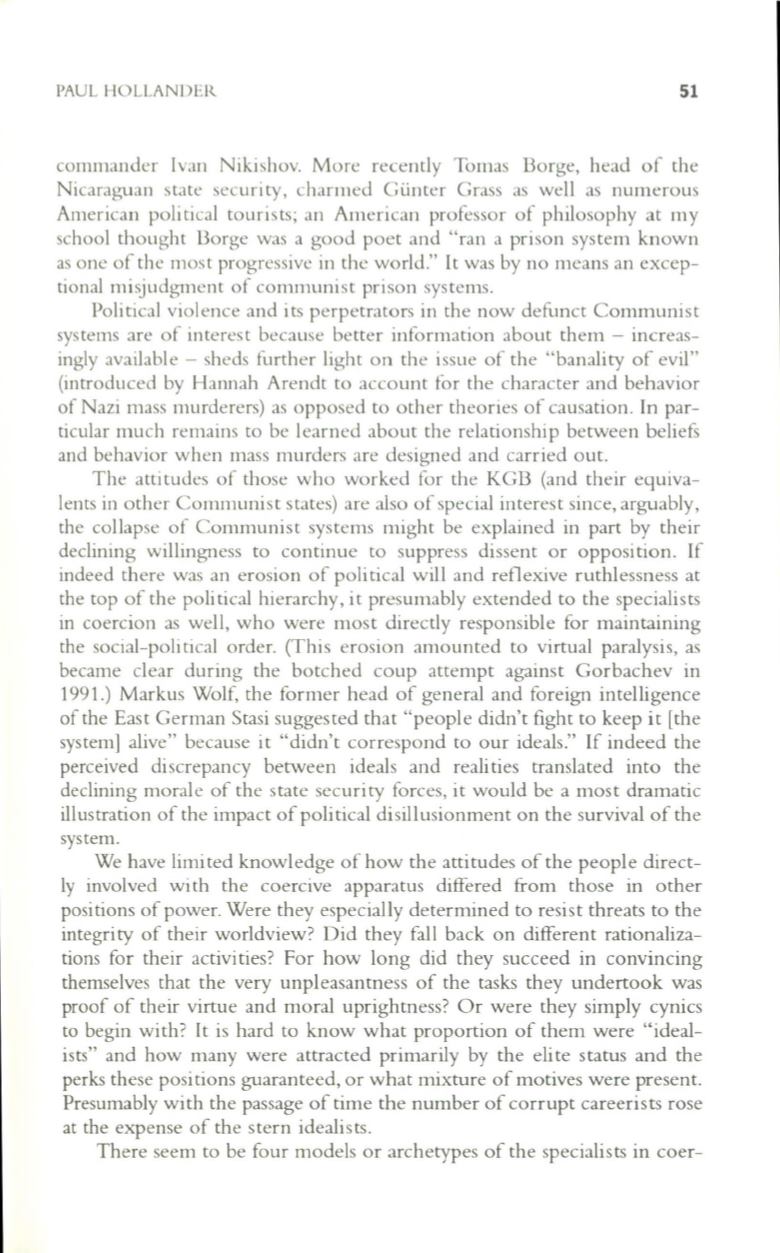
PAUL HOLLANDER
51
commander Ivan Nikishov. More recently Tomas Borge, head of the
Nicaraguan state security, charmed Gunter Grass as well as numerous
American poli tical tourists; an American professor of philosophy at my
school thought Borge was a good poet and "ran a prison system known
as one of the most progressive in the world." It was by no means an excep–
tional misjudgment of communist prison systems.
Political violence and its perpetrators in the now defunct Communist
systems are of interest because better information about them - increas–
ingly available - sheds further light on the issue of the "banality of evil"
(introduced by Hannah Arendt to account for the character and behavior
of Nazi mass murderers) as opposed to other theories of causation. In par–
ticular much remains to be learned about the relationship between beliefs
and behavior when mass murders are designed and carried out.
The attitudes of those who worked for the KGB (and their equiva–
lents in other Communist states) are aho of special interest since, arguably,
the collapse of Communist systems might be explained in part by their
declining willingness to continue to suppress dissent or opposition. If
indeed there was an erosion of poli tical will and reflexive ruthlessness at
the top of the poli tical hierarchy, it presumably extended to the specialists
in coercion as well, who were most directly responsible for maintaining
the social-poli tical order. (This erosion amounted to virtual paralysis, as
became clear during the botched coup attempt against Gorbachev in
1991.) Markus Wolf, the former head of general and foreign intelligence
of the East German Stasi suggested that "people didn't fight to keep it [the
system] alive" because it "didn't correspond to our ideals." If indeed the
perceived discrepancy between ideals and realities translated into the
declining morale of the state security forces, it would be a most dramatic
illustration of the impact of political disillusionment on the survival of the
system.
We have Iimi ted knowledge of how the atti tudes of the people direct–
ly involved with the coercive apparatus differed from those in other
positions of power. Were they especially determined to resist threats to the
integrity of their worldview? Did they fall back on different rationaliza–
tions for their activities? For how long did they succeed in convincing
themselves that the very unpleasantness of the tasks they undertook was
proof of their virtue and moral uprightness? Or were they simply cynics
to begin with? It is hard to know what proportion of them were "ideal–
ists" and how many were attracted primarily by the elite status and the
perks these positions guaranteed, or what mixture of motives were present.
Presumably wi th the passage of time the number of corrupt careerists rose
at the expense of the stern idealists.
There seem to be four models or archetypes of the specialists in coer-


